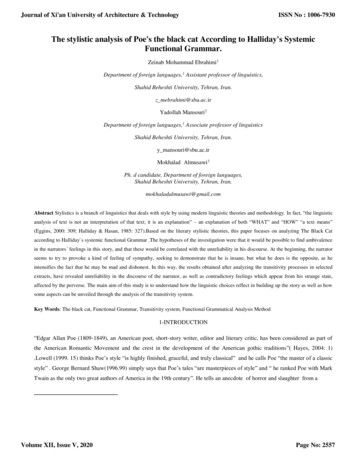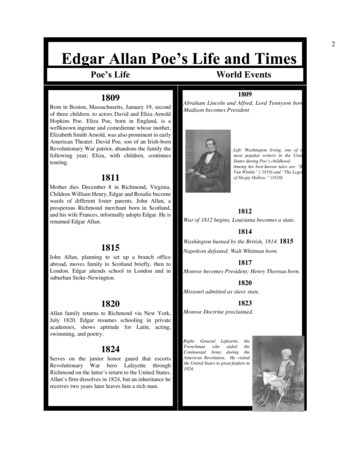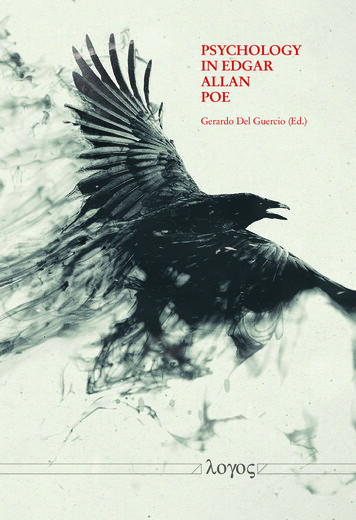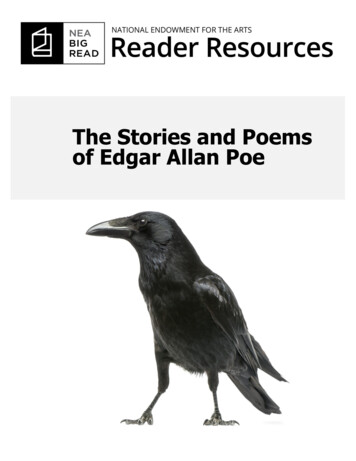
Transcription
Journal of Xi'an University of Architecture & TechnologyISSN No : 1006-7930The stylistic analysis of Poe's the black cat According to Halliday's SystemicFunctional Grammar.Zeinab Mohammad Ebrahimi1Department of foreign languages,1 Assistant professor of linguistics,Shahid Beheshti University, Tehran, Iran.z mebrahimi@sbu.ac.irYadollah Mansouri2Department of foreign languages,1 Associate professor of linguisticsShahid Beheshti University, Tehran, Iran.y mansouri@sbu.ac.irMokhalad Almusawi3Ph. d candidate, Department of foreign languages,Shahid Beheshti University, Tehran, Iran.mokhaladalmusawi@gmail.comAbstract Stylistics is a branch of linguistics that deals with style by using modern linguistic theories and methodology. In fact, “the linguisticanalysis of text is not an interpretation of that text; it is an explanation” – an explanation of both “WHAT” and “HOW” “a text means”(Eggins, 2000: 309; Halliday & Hasan, 1985: 327).Based on the literary stylistic theories, this paper focuses on analyzing The Black Cataccording to Halliday s systemic functional Grammar .The hypotheses of the investigation were that it would be possible to find ambivalencein the narrators feelings in this story, and that these would be correlated with the unreliability in his discourse. At the beginning, the narratorseems to try to provoke a kind of feeling of sympathy, seeking to demonstrate that he is insane, but what he does is the opposite, as heintensifies the fact that he may be mad and dishonest. In this way, the results obtained after analyzing the transitivity processes in selectedextracts, have revealed unreliability in the discourse of the narrator, as well as contradictory feelings which appear from his strange state,affected by the perverse. The main aim of this study is to understand how the linguistic choices reflect in building up the story as well as howsome aspects can be unveiled through the analysis of the transitivity system.Key Words: The black cat, Functional Grammar, Transitivity system, Functional Grammatical Analysis Method1-INTRODUCTION“Edgar Allan Poe (1809-1849), an American poet, short-story writer, editor and literary critic, has been considered as part ofthe American Romantic Movement and the crest in the development of the American gothic traditions”( Hayes, 2004: 1).Lowell (1999. 15) thinks Poe’s style “is highly finished, graceful, and truly classical” and he calls Poe “the master of a classicstyle” . George Bernard Shaw(1996.99) simply says that Poe’s tales “are masterpieces of style” and “ he ranked Poe with MarkTwain as the only two great authors of America in the 19th century”. He tells an anecdote of horror and slaughter from aVolume XII, Issue V, 2020Page No: 2557
Journal of Xi'an University of Architecture & TechnologyISSN No : 1006-7930prison cell.The story tells the changing process of personality from human to perverse. He appears to say that human nature isso vulnerable to outward influences that once it is twisted, the person may have abnormal feelings that push him to makemistakes and commit unthinkable evil deeds . The evil is always punished in the end. The current study will examine EdgerAllen Poe's "the Black Cat" in depth and analyze the sentence structures that convey semantic processes, the participants'involvement in these processes, and the conditions in which processes and participants are involved. Verbs of the sentences willbe described into six processes: Material, mental, behavioral, relational, verbalization, and existential.2-THEORETICAL BACKGROUND2-1 Edgar Allan Poe and Perverseness in His FictionEdgar Allan Poe, a short story writer, critic, and poet achieved a professional success in many European countries (Hayes,2004: 1). However, during the nineteenth century he was not highly regarded by most of his contemporaries in the Englishspeaking countries, given that at that time he was known mainly as a poet, and his work did not achieve professional success.One hundred year later, in the twentieth century, the perception of his figure as well as the perception of his works changed, andhis writings started to enjoy great prestige, becoming even an object of psychoanalytic theory. In fact, three predominantattitudes toward Poe emerged in 1875, prevailed into the twentieth century and have persisted until today: popular claim,measured skepticism and ardent enthusiasm (Hayes, 2004: 2). Edward H. Davidson in his book Poe: A critical Study (1957:115-125), considers Poe as a verbal landscapist of death. For Poe, horror is seen as a region or as a mysterious middle groundwhere the rational faculties of thinking and choice have been suspended. In this sense, horror for him is a psychological method that seeks to understand and examine in depth the states of mind of the characters, to see what they think, what theysay, what they perceive while they are carrying out or undergoing an action, and so on. In general, he creates a fictional world,where characters treat, feel, and think, and readers process and analyze all this information.2-2. Theory of TransitivityIn Functional Grammar, language is considered as a system “comprising three layers or strata”: “a semantic stratum, a lexicogrammatical stratum and a phonological stratum” (Morley, 1985: 48). “The semantic stratum accounts for the different facets ofmeaning in a text: ideational, interpersonal and textual” (ibid). All these systems at every rank are located in theirmetafunctional context. Halliday distinguishes three metafunctions, also known as modes of meaning, which are, according tohim, a property of all languages, which are considered to be shaped and organized in relation to these three types of meaning:the ideational metafunction, concerned with the representation of human experience; the interpersonal metafunction, concernedwith the expression of and the attitudes towards whoever we address, as well as what we are talking about ; and finally, thetextual metafunction, concerned with the construction of the text (Halliday 2014: 29-30). Concerning the ideationalmetafunction, the author distinguishes two components: the experiential and the logical. The ideational metafunction is aresource which enables us to construe our experience of the world that lies around us and inside us, by configuring it intoclauses (2014: 713). The transitivity system, according to Halliday, is a system that construes the world of experience into amanageable set of Process Types (Halliday, 2004: 170), the set of options whereby the speaker encodes his experience of theprocesses of the external world (ibid, 1974: 134). That is to say, clauses represent actions, events and different processes, andthe transitivity system serves to encode how an action is performed, how the speaker or reader encode in language their mentalrepresentations of the world, and how they account for their experience of the world around them. In summary, transitivity isconsidered to be an important and powerful semantic phenomenon, affecting not only the verb, but also its participants andcircumstances (ibid, 1985).Volume XII, Issue V, 2020Page No: 2558
Journal of Xi'an University of Architecture & TechnologyISSN No : 1006-79302.2.1 Participants, Processes and CircumstancesThe semantic schema for the presentation of a process consists of the following components (Halliday 1985: 101 & Downing,2006: 123): the process, which is a technical term for the action, as for example hit or run , for the state, for instance have or forthe change of state, as melt or freeze involved; the participant(s) who are involved in the process. In other terms, who or what is doing what to whom; the attributes which are ascribed to participants; and the circumstances associated with the process, in terms of time, manner and place.2.2.2 Material processes of transitivity are processes of doingThere are two varieties of this type of processes: doing to or dispositive type and bringing about or creative type.Material processes express therefore that some entity does something, which may be done to some other entity (Halliday,1985: 103). Western linguistics considers that every process has an Actor, who carries out the action, and some processes, butnot all, also have a second participant called Goal, which implies directed at or the one to which the process is extended .Indeed, we can consider it as the person or the entity affected by the process (Downing, 2006: 128). An example is presentedbelow (ibid, 1985: 103-104):Table1.Material processActorprocessThe lionSprangThe lionCaughtGoalTourist2.2.3 Mental processesMental processes are processes of sensing . This process of sensing may be construed as flowing from a person sconsciousness or as impinging on it (Halliday, 1985: 107). Mental processes on the other hand are concerned with ourexperience of the world of our own consciousness. Mental processes may be of four sub-types: perception, which refers toprocesses of feeling, seeing, and so forth.; cognition, which refers to processes of thinking, knowing, etc.; emotion/affection,refers to processes of liking, hating, etc.; and desideration, which refers to processes of wanting, and so forth. In a Mentalprocess there is always a conscious participant, the Senser and also called Experiencer, who perceives, knows and so forth,and a second participant, the Phenomenon, which is perceived, known, or liked (Downing, 2006: 139) .Table2.Mental processSheLikesExperiencerVolume XII, Issue V, 2020The giftPhenomenaPage No: 2559
Journal of Xi'an University of Architecture & TechnologyISSN No : 1006-79302.2.4 Relational processes“Relational processes are concerned with the process of being in the world of abstract relations. Normally, an abstractrelationship that exists between two participants associated with the process is considered, but unlike the case of materialprocess, a participant does not affect the other participant in a physical sense.Examples are “John is talented,” and “John is the leader.” The types of relational process are quite complex and controversial”( Eggins 1994:255 ). “For the present analysis, it is sufficient to identify the following two principal process types : theattributive mode in intensive processes and the identifying mode in intensive processes. Intensive, being one of the three mainrelational types i. e., Intensive, Circumstantial, and Possessive , expresses an “x is y” relationship, while Circumstantialdenotes an “x is at y” relationship, and Possessive, an “x has y” relationship. Each of the three types can appear in two distinctmodes :Attributive : “y is an attribute of x”Identifying : “y is the identity of x”Since only the attributive mode and the identifying mode in intensive processes are of particular relevance to the present study,a detailed explanation of the other types Circumstantial and Possessive is unnecessary here” (ibid).2.2.5 Verbal processes: processes of saying and communicatingVerbal processes are processes of saying and communicating realized by verbs like say, talk, etc. (Downing, 2006: 151).Participants are called the Sayer, responsible for verbal process, the Verbiage which is the nominalized statement of thisprocess, and the Reciever, the person at whom the verbal process is directed (Halliday, 1985: 130). However, there is alsoanother type of verbal process, in which the Sayer acts verbally on another participant, with verbs, such as for example abuse orinsult. This direct participant will have the role of a Target, as in I am always praising you to my friends, in which you will bethe Target of the verbal process (ibid, 1985: 132).Table3 : Verbal processesSayerVerbalThe commiteeAnnouncedIToldTargetverbiageThat the new bill be paasedherHow to play the piano2.2.6 Behavioral processesBehavioral processes are processes of physiological and psychological behavior, and they are on the borderline betweenmaterial and mental processes( Halliday 1994 :107). Behavioral processes “represent outer manifestations of inner workings,the acting out of processes of consciousness and physiological states” (ibid 1994 :107 ). Behavioral processes are the leastsalient of Halliday’s six process types, and the boundaries of behavioral processes are indefinite. The participant who isbehaving is called Behaver. Like the Senser, Behaver is usually a conscious being, but the process is more like one of doing, asin material processes.Table 4JohnIs cryingBehaverProcess:behavioralVolume XII, Issue V, 2020Page No: 2560
Journal of Xi'an University of Architecture & TechnologyISSN No : 1006-79302.2.7 Existential processes“Existential processes are those which represent that something happens or exists. They are usually realized by the verb there to be or some other verb which expresses existence, for instance, exist or arise, and they are followed by a nominal group whichfunctions as an Existent, which is often an event, but it can be a phenomenon of any type. Oftentimes an existential processcontains a circumstantial element, as in there was a picture on the wall, and also it is frequently followed by a non-finite clause,as in there s a patient to see you” (Halliday, 1985: 130).Table5: Existential processesThere wasa little houseon the big prairie.existentialExistentCircumstance : PlaceAs a conclusion, below there is a table representing all the process types with their meaning and participants.Table6 : Process types, their meanings and characteristic participants (Halliday, 2014: 311)Process typeCategory ctionDoingEventHappeningBehavioralActor .GoalParticipants.obliqueinvolvedRecipient .attribute. Client.scope. enser DesirationWantingemotionFeelingverbalSayingSayer :targetReceiver: AttributionAttributingIdentified :identifierBeneficiary: assignerIdentificationIdentifiedToken : valueExistentialExistingExistent3. METHOD ACTIONVolume XII, Issue V, 2020Page No: 2561
Journal of Xi'an University of Architecture & TechnologyISSN No : 1006-79303.1 Corpus collection and analysisAfter explaining the aim of this study, various steps were followed so as to collect and analyze the corpus for the studysupplying some examples from the story .First of all, examining the critical essay on Edgar Allan Poe s writing, the short story which was related to the idea of Perverseness , and therefore, the most suitable and relevant to the proposed aims of this study were chosen. The story iswritten in the first-person, which allows the narrator to tell this story is from his point of view. The Black Cat is a firstperson narrative, published in 1843. From the beginning, the narrator comments on his love for animals, and especially the lovefor his beloved cat called Pluto. However, at some point, he starts to drink alcohol and his personality changes for the worst. Hethen starts to maltreat animals, and even kills his cat. Then, he finds a similar cat to Pluto and decides to bring him to his house.One day, when trying to kill this new cat, his wife defends it, so he murders her instead and places her body in a wall. A fewdays later, the police arrive and the man, completely confident accompanies them into the cellar. Suddenly, after hearing ananimal sound, the police paint the wall and find the wife s body inside, with the black cat lying upon her head. Secondly, afterelecting this reading, we have analyzed all transitivity process types in this story, however; only extracts explicitly connected tothe theme of Perverseness , and marking a turning point in the plot, were chosen for the analysis, with the objective ofvalidating or rejecting the proposed hypotheses, that is, to see in fact, if it is possible to find ambivalence of feelings reflectedthrough Halliday s transitivity model, and how this is correlated. In order to accomplish the objectives, a transitivity analysis ofthe story, focusing on the six types of processes –Material, Mental, Verbal,existential, Relational and Behavioral- proposed byHalliday, was carried out.3.2 The InstrumentsThe present study employed the table and figures in the analysis, which present the results (frequencies and percentages) of thedifferent types of processes found in the story, as well as the results obtained after comparing these processes. The functionalgrammatical analysis method was used to analyze the data, while frequencies and percentages were calculated for eachfunctional category by using Excel Consequently.3.3 Analysis of the text .After introducing the theoretical background and the method used for this investigation, the analysis of the text will bepresented in the present section. First of all, Material processes in which the narrators are encoded as Actors will be examined.Then, Mental processes will be presented in which they are encoded as Sensers, Verbal processes, in which they are encodedas Sayers and finally, Behavioral and Relational will be also investigated.Clauses with KEYMaterial processes Blue colorMental processes pink colorVerbal processes Green colorExistential processes turquoise colorBehavioral processes yellowRelational processes Red colorVolume XII, Issue V, 2020Page No: 2562
Journal of Xi'an University of Architecture & TechnologyISSN No : 1006-7930FOR the most wild, yet most homely narrative which I am about to pen, I neither expectnor solicit belief. Mad indeed would I be to expect it, in a case where my very senses reject their own evidence. Yet, mad am Inot — and very surely do I not dream. But to-morrow I die, and to-day I would unburthen my soul. My immediate purpose isto place before the world, plainly, succinctly, and without comment, a series of mere household events. In their consequences,these events have terrified — have tortured - have destroyed me. Yet I will not attempt to expound them. To me, they havepresented little but Horror — to many they will seem less terrible than baroques. Hereafter, perhaps, some intellect may befound which will reduce my phantasm to the common-place — some intellect more calm, more logical, and far less excitablethan my own, which will perceive, in the circumstances I detail with awe, nothing more than an ordinary succession of verynatural causes and effects.From my infancy I was noted for the docility and humanity of my disposition. My tenderness of heart was even so conspicuousas to make me the rest of my companions. I was especially fond of animals, and was indulged by my parents with a greatvariety of pets. With these I spent most of my time, and never was so happy as when feeding and caressing them. This peculiarof character grew with my growth, and in my manhood, I derived from it one of my principal sources of pleasure. To thosewho have cherished an affection for a faithful and sagacious dog, I need hardly be at the trouble of explaining the nature or theintensity of the gratification thus derivable. There is something in the unselfish and self-sacrificing love of a brute, which goesdirectly to the heart of him who has had frequent occasion to test the paltry friendship and gossamer fidelity of mere Man. Imarried early, and was happy to find in my wife a disposition not uncongenial with my own. Observing my partiality fordomestic pets, she lost no opportunity of procuring those of the most agreeable kind. We had birds, gold fish, a fine dog,rabbits, a small monkey, and a cat.This latter was a remarkably large and beautiful animal, entirely black, and sagacious to an astonishing degree. In speaking ofhis intelligence, my wife, who at heart was not a little tinctured with superstition, made frequent allusion to the ancient popularnotion, which regarded all black cats as witches in disguise. Not that she was ever serious upon this point — and I mention thematter at all for no better reason than that it happens, just now, to be remembered.Pluto — this was the cat’s name — was my favorite pet and playmate. I alone fed him, and he attended me wherever I wentabout the house. It was even with difficulty that I could prevent him from following me through the streets.Our friendship lasted, in this manner, for several years, during which my general temperament and character — through theinstrumentality of the Fiend Intemperance — had (I blush to confess it) experienced a radical alteration for the worse. I grew,day by day, more moody, more irritable, more regardless of the feelings of others. I suffered myself to use intemperatelanguage to my At length, I even offered her personal violence. My pets, of course, were made to feel the change in mydisposition. I not only neglected, but ill-used them. For Pluto, however, I still retained sufficient regard to restrain me frommaltreating him, as I made no scruple of maltreating the rabbits, the monkey, or even the dog, when by accident, or throughaffection, they came in my way. But my disease grew upon me — for what disease is like Alcohol! — and at length even Pluto,who was now becoming old, and consequently somewhat peevish — even Pluto began to experience the effects of my illtemper.One night, returning home, much intoxicated, from one of my haunts about town, I fancied that the cat avoided my presence. Iseized him; when, in his fright at my violence, he inflicted a slight wound upon my hand with his teeth. The fury of a demoninstantly possessed me. I knew myself no longer. My original soul seemed, at once, to take its flight from my body; and a morethan fiendish malevolence, gin-nurtured, thrilled every fibre of my frame. I took from my waistcoat-pocket a pen-knife, openedit, grasped the poor beast by the throat, and deliberately cut one of its eyes from the socket! I blush, I burn, I shudder, while Ipen the damnable atrocity.When reason returned with the morning — when I had slept off the fumes of the night’s debauch — I experienced a sentimenthalf of horror, half of remorse, for the crime of which I had been guilty; but it was, at best, a feeble and equivocal feeling, andthe soul remained untouched. I again plunged into excess, and soon drowned in wine all memory of the deed.In the meantime the cat slowly recovered. The socket of the lost eye presented, it is true, a frightful appearance, but he nolonger appeared to suffer any pain. He went about the house as usual, but, as might be expected, fled in extreme terror at myapproach. I had so much of my old heart left, as to be at first grieved by this evident dislike on the part of a creature which hadonce so loved me. But this feeling soon gave place to irritation. And then came, as if to my final and irrevocable overthrow, thespirit of PERVERSENESS. Of this spirit philosophy takes no account. Yet I am not more sure that my soul lives, than I am thatperverseness is one of the primitive impulses of the human heart — one of the indivisible primary faculties, or sentiments,which give direction to the character of Man. Who has not, a hundred times, found himself committing a vile or a silly action,for no other reason than because he knows he should not? Have we not a perpetual inclination, in the teeth of our bestjudgment, to violate that which is Law, merely because we understand it to be such? This spirit of perverseness, I say, came tomy final overthrow. It was this unfathomable longing of the soul to vex itself — to offer violence to its own nature — to dowrong for the wrong’s sake only — that urged me to continue and finally to consummate the injury I had inflicted upon theunoffending brute. One morning, in cool blood, I slipped a noose about its neck and hung it to the limb of a tree; — hung itwith the tears streaming from my eyes, and with the bitterest remorse at my heart; — hung it because I knew that it had lovedme, and because I felt it had given me no reason of offence; — hung it because I knew that in so doing I was committing a sinVolume XII, Issue V, 2020Page No: 2563
Journal of Xi'an University of Architecture & TechnologyISSN No : 1006-7930— a deadly sin that would so jeopardize my immortal soul as to place it — if such a thing were possible— even beyond thereach of the infinite mercy of the Most Merciful and Most Terrible God.On the night of the day on which this cruel deed was done, I was aroused from sleep by the cry of fire. The curtains of my bedwere in flames. The whole house was blazing. It was with great difficulty that my wife, a servant, and myself, made our escapefrom the conflagration. The destruction was complete. My entire worldly wealth was swallowed up, and I resigned myselfthenceforward to despair.I am above the weakness of seeking to establish a sequence of cause and effect, between the disaster and the atrocity. But I amdetailing a chain of facts — and wish not to leave even a possible link imperfect. On the day succeeding the fire, I visited theruins. The walls, with one exception, had fallen in. This exception was found in a compartment wall, not very thick, whichstood about the middle of the house, and against which had rested the head of my bed. The plastering had here, in greatmeasure, resisted the action of the fire — a fact which I attributed to its having been recently spread. About this wall a densecrowd were collected, and many persons seemed to be examining a particular portion of it with every minute and eagerattention. The words “strange!” “singular!” and other similar expressions, excited my curiosity. I approached and saw, as ifgraven in bas relief upon the white surface, the figure of a gigantic cat. The impression was given with an accuracy trulymarvellous. There was a rope about the animal’s neck.When I first beheld this apparition — for I could scarcely regard it as less — my wonder and my terror were extreme. But atlength reflection came to my aid. The cat, I remembered, had been hung in a garden adjacent to the house. Upon the alarm offire, this garden had been immediately filled by the crowd — by some one of whom the animal must have been cut from thetree and thrown, through an open window, into my chamber. This had probably been done with the view of arousing me fromsleep. The falling of other walls had compressed the victim of my cruelty into the substance of the freshly-spread plaster; thelime of which, had then with the flames, and the ammonia from the carcass, accomplished the portraiture as I saw it. Although Ithus readily accounted to my reason, if not altogether to my conscience, for the startling fact ‘just detailed, it did not the less fallto make a deep impression upon my fancy. For months I could not rid myself of the phantasm of the cat; and, during thisperiod, there came back into my spirit a half-sentiment that seemed, but was not, remorse. I went so far as to regret the loss ofthe animal, and to look about me, among the vile haunts which I now habitually frequented, for another pet of the samespecies, and of somewhat similar appearance, with which to supply its place.One night as I sat, half stupefied, in a den of more than infamy, my attention was suddenly drawn to some black object,reposing upon the head of one of the immense hogsheads of Gin, or of Rum, which constituted the chief furniture of theapartment. I had been looking steadily at the top of this hogshead for some minutes, and what now caused me surprise was thefact that I had not sooner perceived the object thereupon. I approached it, and touched it with my hand. It was a black cat —avery large one — fully as large as Pluto, and closely resembling him in every respect but one. Pluto had not a white hair uponany portion of his body; but this cat had a large, although indefinite splotch of white, covering nearly the whole region of thebreast.Upon my touching him, he immediately arose, purred loudly, rubbed against my hand, and appeared delighted with my notice.This, then, was the very creature of which I was in search. I at once offered to purchase it of the landlord; but this person madeno claim to it — knew nothing of it —had never seen it before.I continued my caresses, and, when I prepared to go home, the animal evinced a disposition to accompany me. I permitted itto do so; occasionally stooping and patting it as I proceeded. When it reached the house it domesticated itself at once, andbecame immediately a great favorite with my wife.For my own part, I soon found a dislike to it arising within me. This was just the reverse of what I had anticipated; but I knownot how or why it was — its evident fondness for myself rather disgusted and annoyed. By slow degrees, these feelings ofdisgust and annoyance rose into the bitterness of hatred. I avoided the creature; a certain sense of shame, and the remembranceof my former deed of cruelty, preventing me from physically abusing it. I did not, for some weeks, strike, or otherwiseviolently ill use it; but gradually — very gradually — I came to look upon it with unutterable loathing, and to flee silently fromits odious presence, as from the breath of a pestilence.What added, no doubt, to my hatred of the beast, was the discovery, on the morning after I brought it home, that, like Pluto, italso had been deprived of one of its eyes. This circumstance, however, only endeared it to my wife, who, as I have alreadysaid, possessed, in a high degree, that humanity of feeling which had once been my distinguishing trait, and the source of manyof my simplest and purest pleasures.With my aversion to this cat, however, its partiality for myself seemed to increase. It followed my footsteps with a pertinacitywhich it would be difficult to make the reader comprehend. Whenever I sat, it would crouch beneath my chair, or springupon my knees, covering me with its loathsome caresses. If I arose to walk it would get between my feet and thus nearlythrow me down, or, fastening its long and sharp claws in my dress, clamber, in this manner, to my breast. At s
Key Words: The black cat, Functional Grammar, Transitivity system, Functional Grammatical Analysis Method 1-INTRODUCTION “Edgar Allan Poe (1809-1849), an American poet, short-story writer, e










